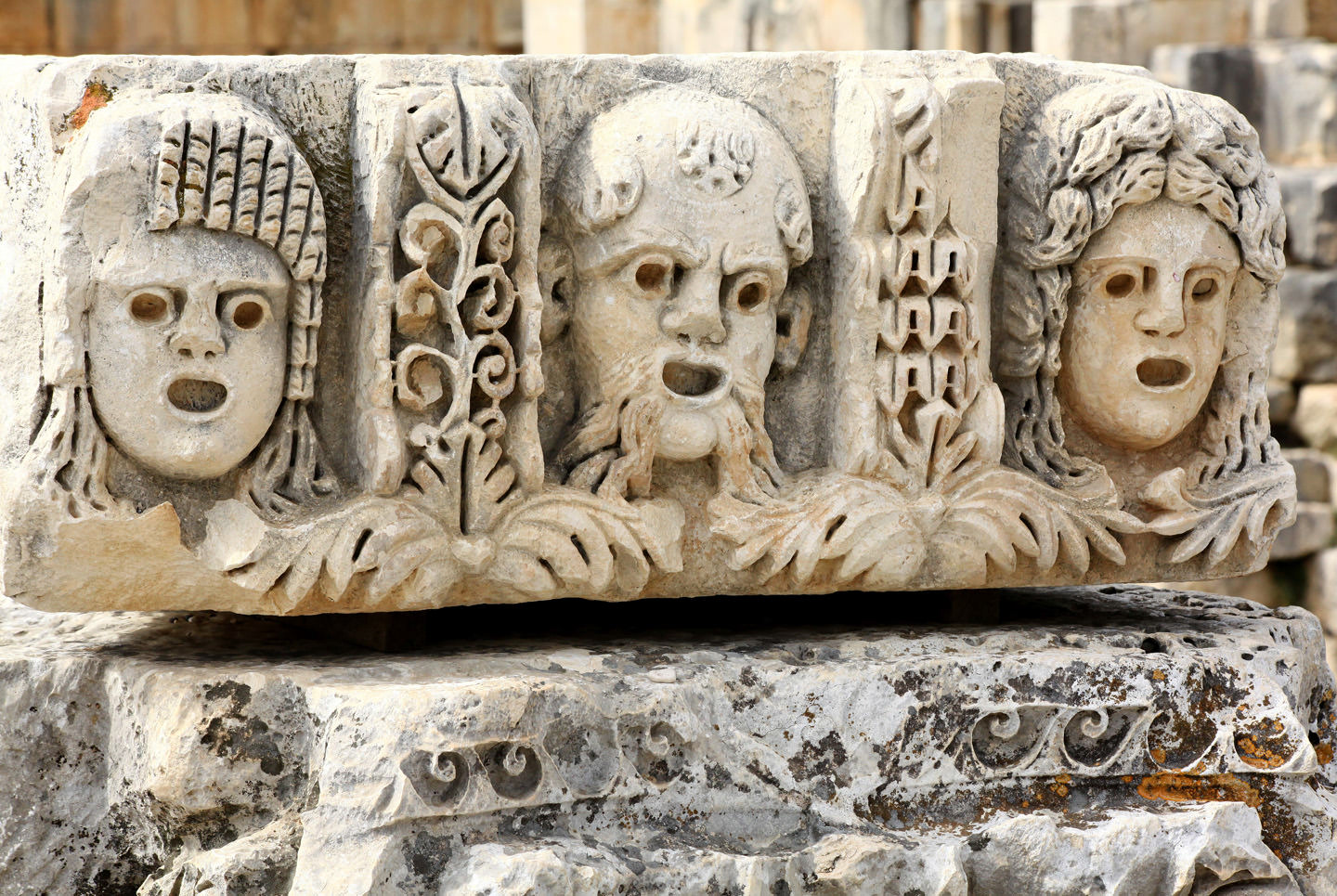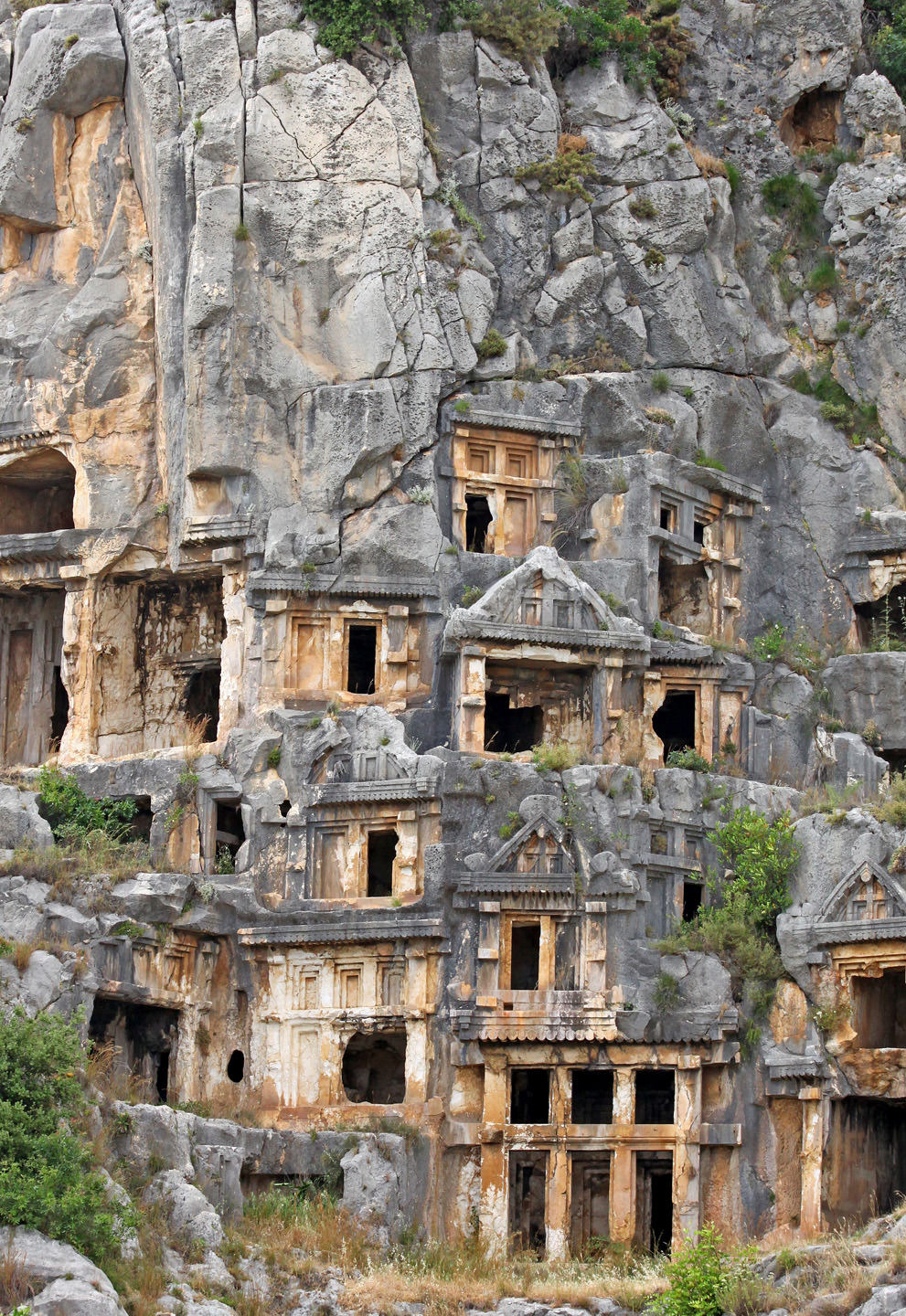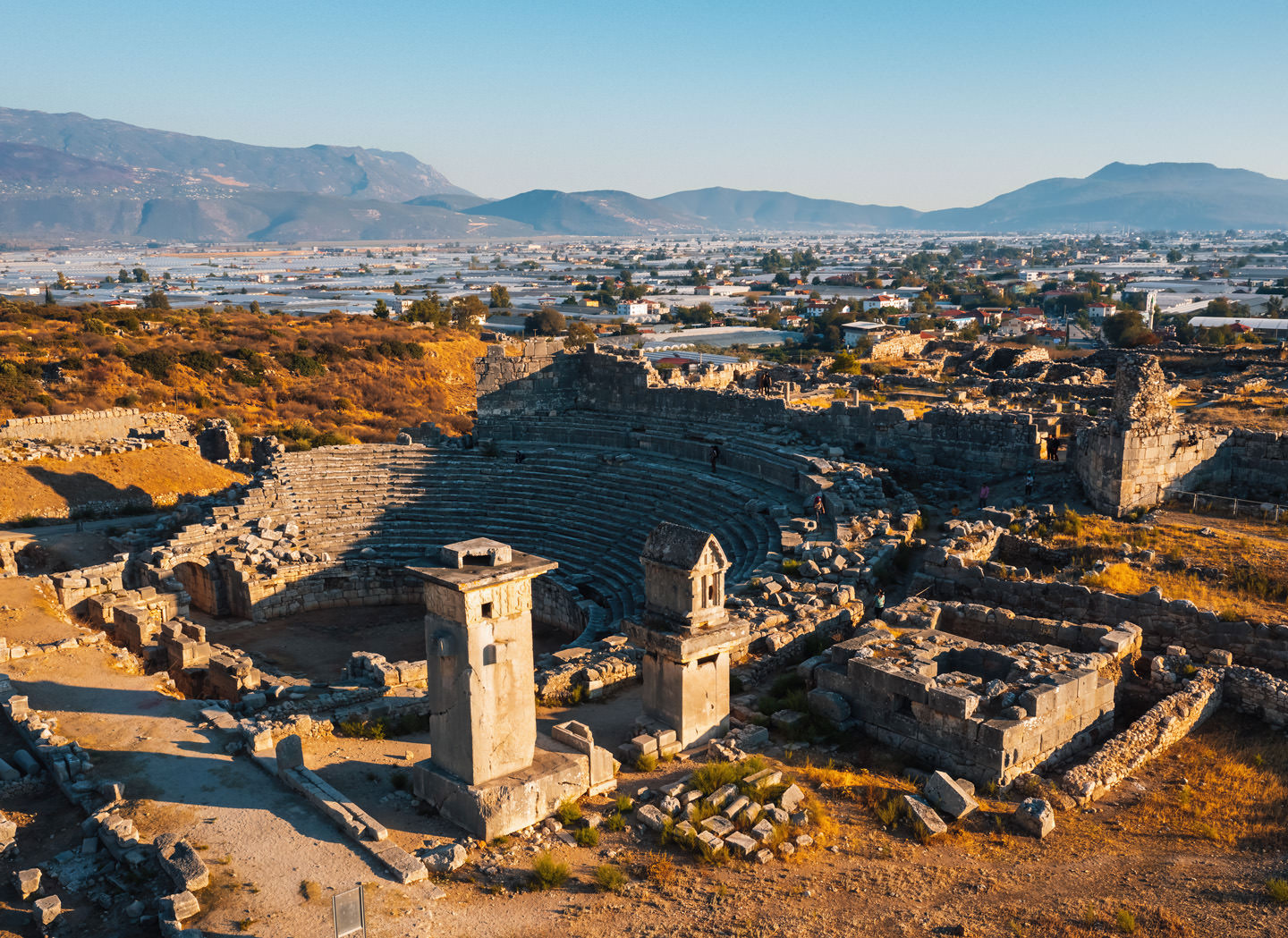In head and shoulders,
she was like a lion,
in back and tail, a snake, and in
the middle,
a she-goat, and she breathed a
dreadful blast
of blazing fire.
This is the Chimera in The Iliad, as translated by classicist Emily Wilson. Legend says the fire-breathing monster ravaged the people of Lycia, was slain by Bellerophon astride Pegasus, and lives on in metamorphic flames on the steep slopes of southwestern Anatolia in modern-day Turkey.
She also dwells in my thoughts: a chimera or illusion, as the word now more commonly means. As I tour the Lycian coast, the otherworldly and many-layered (and -limbed) past follows me in this mythical land strewn with ancient deities and ruins.
Other legendary names from Greek mythology saturate this rugged little knob of land, a semi-circular peninsula that juts into the Mediterranean. Apollo and Artemis, and the divine heroes’ mother, Leto, have temples dedicated to them at the Letoon archeological site. Alexander the Great was in Lycia. And Lycian soldiers—including a son of Zeus—sailed from here to fight for the Trojans against Achilles and Agamemnon.
Like the many gods, demigods, and mythic creatures that linger in Lycia, the landscape is littered with ruins many millennia old. In a handful of days, I see slews of open-air theatres and innumerable slabs of ancient stone, rock-cut tombs, still-standing and toppled columns—Ionic, Doric, Corinthian—and the hollow eyes and gaping mouths of theatrical mask sculptures carved in great blocks of limestone.
At Letoon, my feet are caked in dust as I walk between the remains of a theatre and the temples of Leto and her children. I scramble up the massive stones to stand atop the base of a fallen column, arms akimbo. I try to channel the stance of the formidable hunter goddess, Artemis, more than two millennia since these columns were erected in 337 BC.
I do the same in Xanthos, the largest city-state in Lycia’s heyday, but from the bottom of another theatre with my arms stretched sideways, Gladiator style. Are you not entertained? I think. Yes. This storied land enchants. Above the clouds hugging the hilltop fortress of Tlos, the white wisps echo the flowing mane of Pegasus. In Patara, I climb the stairs of the striking amphitheatre-like assembly hall and sit in the centre as if I’m a representative of the Lycian League. And I may have been; this once thriving and progressive civilization was a matrilineal society and the original model of a democratic confederacy based on popular and proportional representation—lauded by the “father” of the American constitution, James Madison, in 1787.

Remains of a theatre. Courtesy of Go Türkiye.
Lycia’s many layers include Greek, Roman, Persian, Byzantine, and Christian influences, and yet it retained a distinct culture, from its matriarchy to its funerary architecture. As I criss-cross the Likya Yolu, or Lycian Way, a revived and now-preserved network of trails and ancient byways (some 760 kilometres between the port cities Fethiye and Antalya), spectacular rock-cut and pillar tombs dot the surrounding landscape, dating back to the fourth century BC, alongside smaller tombs with ogee roofs—like the upside-down hulls of boats—scattered in the centre of towns, where they now serve as odd landmarks and improvised benches for locals on their mobile phones.
That amalgamation—of old and new, myth and reality, tangible and ethereal, harbinger and scapegoat, terrible and timorous, good and evil—is everywhere in Lycia.
The Lycian Way was mapped by Kate Clow in 1999, a British expat and pioneer of sustainable tourism in Turkey who recognized the historical and cultural significance and beauty of this region. But she wasn’t the first modern-day female explorer to praise the spectacularly shapely shores of the Turquoise Coast.
Freya Stark was an intrepid woman traveller and writer who explored Lycia in the early 1950s and commented on its archaeology, history, mythology, and sublime scenery—from hot resinous scents and the twist of pine boughs to “blocks gnawed by the sea for more than two thousand years.”

Theatre masks. Courtesy of Go Türkiye.
She describes the volcanic vestige of the felled Chimera’s tongue as “a tired flame out of the hillside.” Roman philosopher Pliny the Elder made the first connection between the Chimera myth and a volcano. Named for its mythic muse, the active Mount Chimaera in Beydağları Coastal National Park has flaming gas vents called Yanartaş or Burning Rock, and has long been used as a navigational beacon by Lycian sailors.
I try to imagine a Lycian from the 13th century BC looking at the blaze from within the mountainside as the personification of the Chimera. The ancient Greek poet Hesiod described her as raging fire, fearful, great, swift-footed, and grim-eyed. Virgil, too, wrote about this female beast, relegated to the gates of Hades with other hybrid horrors—centaurs, gorgons, harpies, and the three-headed watchdog Cerberus.
These descriptions are at odds with the scenic serenity of this place—a dichotomy that’s not lost on me as a woman. In modern science, chimera has also become a biological term for an organism with genetically distinct cells or tissues, cobbled together like Frankenstein. Popular culture is rife with the mythical progeny of the Chimera: mutants and fantastical beasts such as Mary Shelley’s monster, the shapeshifting selkies of Irish folklore, X-Men, and even Godzilla, a “strange beast” or kaiju that’s a manifestation of human-caused destruction. That amalgamation—of old and new, myth and reality, tangible and ethereal, harbinger and scapegoat, terrible and timorous, good and evil—is everywhere in Lycia.

Lycian rock-cut tombs in the ancient city of Myra. Courtesy of Go Türkiye.
I see it in the famous Harpy Tomb, raised high on a pillar in Xanthos, once the largest city of the Lycian civilization. Harpies are yet another odious female beast, which carried the dead into the afterlife, but the tomb’s carvings seem almost tender: winged sirens in midflight, gently grasping diminutive females and delivering them to eternal rest. These female figures, flying across millennia, feel resoundingly relevant. (The British archeologist who “discovered” the tomb was so enamoured, he removed the original marble reliefs and shipped them to England where they’ve sat in the British Museum since 1848, despite efforts to have them repatriated.)
Like the characters in The Iliad, harpies and sirens bristle and breathe in Lycia, and are a potent reminder of life and death—and that humanity hasn’t changed much nearly 3,000 years after Homer. The glory and pathos of war, the yearning for and fragility of fame, the fallibility and mortality of humans, rage and lust, love and grief—they’re all in Lycian archeology and the epic poem that Wilson’s translation makes accessible and relevant to today’s readers, as “she scrapes away at old, encrusted layers, until she exposes what lies beneath,” as one reviewer says.
Lycia, too, is thick with layers and legends in architectural ruins that have survived across millennia—buried under sand for centuries, bleached and bitten by the sun and wind, crumbling amid traffic in the seaside resort town of Kaş, choked by flora on the slopes of the Lycian Way, trod on by stray dogs and curious tourists, and carted off to London.
Here, time peels away and the past penetrates the present. As Stark wrote during her journey in Lycia, “The past holds our future.” Millennia after the Lycians, we’ve learned so much and nothing at all. The eons extend endlessly, while human life is a blip. Glaucus, the Lycian soldier, says in Wilson’s translation of The Iliad:
The generations
of men are like the growth and
fall of leaves.
The wind shakes some to earth.
The forest sprouts
new foliage, and springtime
comes. So too,
one human generation comes
to be,
another ends.
And as I wander amid more tumbled columns, lintels, pediments, and sarcophagi, and stand atop yet another ancient theatre overlooking the sea or palm a shard of stone at Leto’s temple, a chimera comes to me. Women wearing diadems and chitons, a stockinged Stark, the tattooed Wilson—and the allegorical winged sirens and demonized Chimera. Together across time. Women who literally and figuratively explored and defined this land. I nod in acknowledgement and wonder.
Read more from our Spring 2025 issue.









